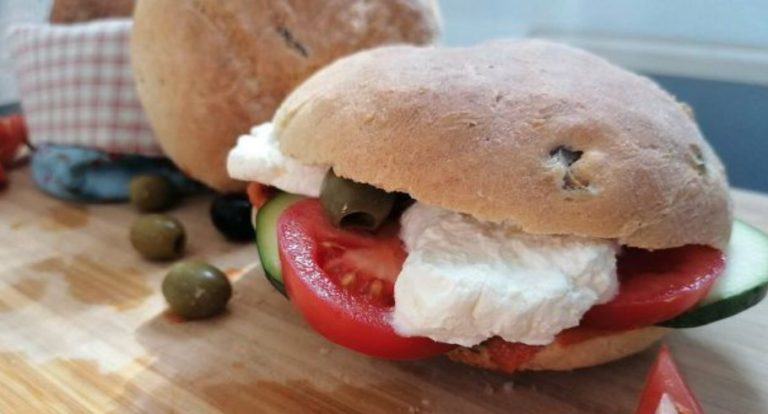Cime di rapa are leafy greens that taste like broccoli. Here you can find out where and when the stem cabbage grows and how you can get it in Germany. We also present a typical Apulian recipe.
Cime di rapa are also known as Italian broccoli, wild broccoli or collards. Literally translated, the term means something like “turnip sprouts” or “turnip tops”. The vegetable has long-stemmed leaves and small inflorescences that look like broccoli florets. The inflorescences are edible if they have not yet blossomed, as are the leaves and stems. While cime di rapa is widespread in Italy and the Mediterranean region in general, they are less common in Germany.
The name “wild broccoli” is not only due to its appearance: it is also similar to conventional broccoli in taste. However, the stalk cabbage has a bitter note and a slight spiciness. If you want to tone down these flavors, you can blanch the vegetables.
Cime di rapa are a popular ingredient, especially in Apulian cuisine. Apulia is a region located in south-eastern Italy. There, for example, stalk cabbage is part of the traditional pasta dish “Orecchiette alle cime di rapa”. We present a recipe for this further down in the article.
Wild broccoli in the kitchen: how to prepare it

There are many ways to prepare cime di rapa.
A simple method is to cook the buds, stalks, and leaves of the kale in the pan. You can stew, steam, stew or roast the vegetables.
Wild broccoli from the pan is a good vegetable side dish for various dishes.
You can also use the kale as a soup ingredient, for example in a minestrone recipe, or add it to pasta dishes and casseroles.
Even if you want to make pesto yourself, Cime di rapa is a good base.
Orecchiette alle cime di rapa: tips & hints
A classic stalk cabbage recipe from Apulia is “Orecchiette alle cime di rapa”. Orecchiette is a special type of pasta named for its ear-like shape. Traditionally, “Orecchiette alle cime di rapa” contain anchovies in addition to vegetables. Here we present a vegan recipe without anchovies. If you want, you can alternatively replace the small fish with salted capers.
Important: When cooking, use ingredients of organic quality whenever possible – you can recognize them by the corresponding certificate. For example, the Demeter seal and the Bioland seal are recommended. They identify ecologically sustainable products that are free of chemical-synthetic pesticides.
In order to avoid long transport routes with high CO2 emissions, it is also worth buying regionally and seasonally. Unfortunately, this is usually not possible with Cime di rapa. Most of the other ingredients you get in the summer months but from German cultivation.
Apulian recipe: Orecchiette alle cime di rapa
Ingredients:
500 g Cime di rapa
Salt
180 g orecchiette
1 small onion
1 clove(s) garlic
10 dried tomatoes (in oil)
1peperoncino pod (fresh)
2 tbsp olive oil
salt and pepper
Directions:
Wash the cime di rapa and drain well. Cut off and discard any stems that are hollow, woody, or overly thick.
Cut or pluck the leaves, buds, and thinner stems into small pieces.
Fill a large saucepan with plenty of water and bring to a boil. Salt the water and add the pasta.
Follow the time on the package and add the kale to the noodles six minutes before the end of the cooking time.
While the pasta and kale are cooking, you can prepare the rest of the vegetables: Peel and finely chop the onion and garlic. Wash the tomatoes and the peperoncino and cut them into small pieces.
Heat the olive oil in a pan. Fry the onion and garlic briefly and then add the tomatoes and the pepperoncini. Add a little pasta water to the pan and let the vegetables simmer for another 2-3 minutes.
Drain the pasta and kale and let them drain well. Then mix them with the vegetables and stock and season with salt and pepper.
When and where does the kale grow?
In Italy, cime di rapa is grown in consecutive batches two to three months apart. They can be harvested almost all year round. Only in midsummer can it be difficult to find the kale on Italian markets at times. In Germany you can buy Cime di rapa between October and April. The goods are mostly imported from Italy.
Because cime di rapa is not very common in German cuisine, it can be difficult to find the “wild broccoli” in this country. The best thing to do is to try your luck at the larger weekly markets or in the Italian delicatessen. Sometimes Turkish specialty shops also offer cime di rapa under the name “Rappa” or “Rapa”.
Plant cime di rapa yourself

If you’re unsuccessful in finding collards, it’s worth considering planting them yourself. So you are not dependent on imported goods and avoid long transport routes.
When: You can sow the seeds outdoors between June and October. In winter, Cime di rapa can also be grown in a greenhouse.
Location: The plants need a sunny to semi-shady location. They do not make any great demands on the soil.
Sowing: Sow the seeds in rows 40 centimeters apart. You should use the seeds themselves at intervals of 20 to 30 centimeters and press them one to two centimeters deep into the soil. After they have germinated, it is best to separate the plantlets four to six centimeters apart.
Care: Cime di rapa are easy to care for – it is enough to water them regularly, especially during dry periods. Also, you can occasionally hoe the soil to loosen it.
Harvest: The kale is ready for harvest five to seven weeks after sowing.
However, it is not easy to get hold of (organic) seeds for Cime di rapa in Germany. The best thing to do is to try it in a well-stocked garden shop or online.



